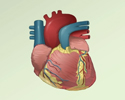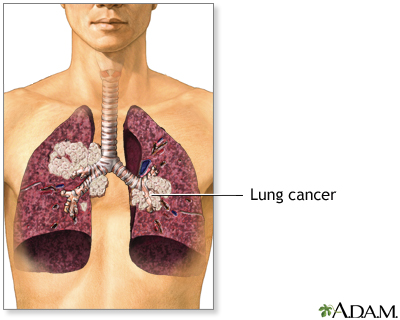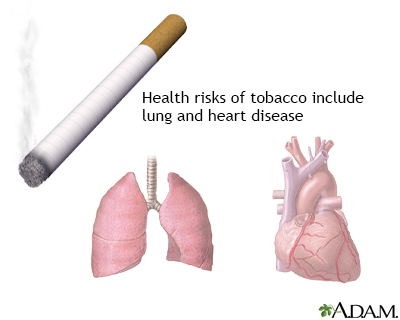Risks of tobacco
Knowing the serious health risks of using tobacco may help motivate you to quit. Using tobacco over a long time can increase your risk for many health problems.
Information
Tobacco is a plant. Its leaves are smoked, chewed, or sniffed for a variety of effects.
- Tobacco contains the chemical nicotine, which is an addictive substance.
- Tobacco smoke contains more than 7,000 chemicals, at least 70 of which are known to cause cancer.
- Tobacco that is not burned is called smokeless tobacco. Including nicotine, there are at least 30 chemicals in smokeless tobacco that are known to cause cancer.
HEALTH RISKS OF SMOKING OR USING SMOKELESS TOBACCO
There are many health risks from smoking and using tobacco. The more serious ones are listed below.
Heart and blood vessel problems:
- Blood clots and weakness in the walls of blood vessels in the brain, which can lead to stroke
Blood clots
Blood clots are clumps that occur when blood hardens from a liquid to a solid. A blood clot that forms inside one of your veins or arteries is calle...
 ImageRead Article Now Book Mark Article
ImageRead Article Now Book Mark ArticleWeakness in the walls of blood vessels
An aneurysm is a weak area in the wall of a blood vessel that causes the blood vessel to bulge or balloon out. When an aneurysm occurs in a blood ve...
 ImageRead Article Now Book Mark Article
ImageRead Article Now Book Mark ArticleStroke
A stroke occurs when blood flow to a part of the brain stops. A stroke is sometimes called a "brain attack. " If blood flow is cut off for longer th...
 ImageRead Article Now Book Mark Article
ImageRead Article Now Book Mark Article - Blood clots in the legs, which may travel to the lungs
Blood clots in the legs
Deep vein thrombosis (DVT) is a condition that occurs when a blood clot forms in a vein deep inside a part of the body. DVT mainly affects the large...
 ImageRead Article Now Book Mark Article
ImageRead Article Now Book Mark Article - Coronary artery disease, including angina and heart attack
Coronary artery disease
Coronary heart disease is a narrowing of the blood vessels that supply blood and oxygen to the heart. Coronary heart disease (CHD) is also called co...
 ImageRead Article Now Book Mark Article
ImageRead Article Now Book Mark ArticleAngina
Angina is a type of chest discomfort or pain due to poor blood flow through the blood vessels (coronary arteries) of the heart muscle (myocardium). ...
 ImageRead Article Now Book Mark Article
ImageRead Article Now Book Mark Article - Temporarily increased blood pressure after smoking
Increased blood pressure
Blood pressure is a measurement of the force exerted against the walls of your arteries as your heart pumps blood to your body. Hypertension is the ...
 ImageRead Article Now Book Mark Article
ImageRead Article Now Book Mark Article - Poor blood supply to the legs
- Problems with erections because of decreased blood flow into the penis
Problems with erections
An erection problem occurs when a man cannot get or keep an erection that is firm enough for intercourse. You may not be able to get an erection at ...
 ImageRead Article Now Book Mark Article
ImageRead Article Now Book Mark Article
Tobacco use - effects on arteries - Animation
Here, we see a comparison of an artery affected with plaque in a non-smoker and smoker. The artery of the smoker is at greater risk for developing complications since smoking constrict arteries, predisposing them to clotting by altering platelet function and coagulability of blood. The result is blockage of the artery.
Other health risks or problems:
- Cancer (more likely in the lung, mouth, larynx, nose and sinuses, throat, esophagus, stomach, bladder, kidney, pancreas, cervix, colon, and rectum)
- Poor wound healing after surgery
- Lung problems, such as chronic obstructive pulmonary disease (COPD), or asthma that is harder to control
Chronic obstructive pulmonary disease
Chronic obstructive pulmonary disease (COPD) is a common lung disease. Having COPD makes it hard to breathe. There are two main forms of COPD:Chroni...
 ImageRead Article Now Book Mark Article
ImageRead Article Now Book Mark ArticleAsthma
Asthma is a chronic disease that causes the airways of the lungs to swell and narrow. It leads to breathing difficulty such as wheezing, shortness o...
 ImageRead Article Now Book Mark Article
ImageRead Article Now Book Mark Article - Problems during pregnancy, such as babies born at a low birth weight, early labor, losing your baby, and cleft lip
Early labor
A premature infant is a baby born before 37 full weeks of gestation (more than 3 weeks before the due date).
Read Article Now Book Mark ArticleLosing your baby
A miscarriage is the spontaneous loss of a fetus before the 20th week of pregnancy. Pregnancy losses after the 20th week are called stillbirths. Mi...
 ImageRead Article Now Book Mark Article
ImageRead Article Now Book Mark ArticleCleft lip
Cleft lip and palate are birth defects that affect the upper lip and the roof of the mouth.
 ImageRead Article Now Book Mark Article
ImageRead Article Now Book Mark Article - Decreased ability to taste and smell
- Harm to sperm, which may lead to infertility
Infertility
Infertility means you cannot get pregnant (conceive). There are 2 types of infertility:Primary infertility refers to couples who have not become preg...
 ImageRead Article Now Book Mark Article
ImageRead Article Now Book Mark Article - Loss of sight due to an increased risk of macular degeneration
Macular degeneration
Macular degeneration is an eye disorder that slowly destroys sharp, central vision. This makes it difficult to see fine details and read. The diseas...
 ImageRead Article Now Book Mark Article
ImageRead Article Now Book Mark Article - Tooth and gum diseases
- Wrinkling of the skin
Smokers who switch to smokeless tobacco instead of quitting tobacco still have health risks:
- Increased risk for cancer of the mouth, tongue, esophagus, and pancreas
- Gum problems, tooth wear, and cavities
Cavities
Dental cavities are holes (or structural damage) in the teeth.
 ImageRead Article Now Book Mark Article
ImageRead Article Now Book Mark Article - Worsening high blood pressure and angina
HEALTH RISKS OF SECONDHAND SMOKE
Those who are often around the smoke of others (secondhand smoke) have a higher risk for:
- Heart attack and heart disease
- Lung cancer
Lung cancer
Small cell lung cancer (SCLC) is a fast-growing type of lung cancer. It spreads much more quickly than non-small cell lung cancer. There are two typ...
 ImageRead Article Now Book Mark Article
ImageRead Article Now Book Mark Article - Sudden and severe irritant reactions, including of the eye, nose, throat, and lower respiratory tract
Infants and children who are often exposed to secondhand smoke are at risk for:
- Asthma flares (children with asthma who live with a smoker are much more likely to visit the emergency room)
- Infections of the mouth, throat, sinuses, ears, and lungs
- Lung damage (poor lung function)
- Sudden infant death syndrome (SIDS)
Sudden infant death syndrome
Sudden infant death syndrome (SIDS) is the unexpected, sudden death of a child under age 1. An autopsy does not show an explainable cause of death....
Read Article Now Book Mark Article
Like any addiction, quitting tobacco is difficult, especially if you are doing it alone.
- Seek support from family members, friends, and coworkers.
- Talk to your health care provider about nicotine replacement therapy and smoking cessation medicines.
Nicotine replacement therapy
Nicotine replacement therapy is a treatment to help people stop smoking. It uses products that supply low doses of nicotine. These products do not ...
 ImageRead Article Now Book Mark Article
ImageRead Article Now Book Mark ArticleSmoking cessation medicines
Your health care provider can prescribe medicines to help you quit tobacco use. These medicines do not contain nicotine and are not habit-forming. ...
 ImageRead Article Now Book Mark Article
ImageRead Article Now Book Mark Article - Join a smoking cessation program and you will have a much better chance of success. Such programs are offered by hospitals, health departments, community centers, and work sites.
Smoking cessation program
It is hard to quit smoking if you are acting alone. Smokers usually have a much better chance of quitting with a support program. Stop smoking prog...
 ImageRead Article Now Book Mark Article
ImageRead Article Now Book Mark Article
Reviewed By
Linda J. Vorvick, MD, Clinical Professor, Department of Family Medicine, UW Medicine, School of Medicine, University of Washington, Seattle, WA. Also reviewed by David C. Dugdale, MD, Medical Director, Brenda Conaway, Editorial Director, and the A.D.A.M. Editorial team.
Atkinson DL, Minnix J, Cinciripini PM, Karam-Hage M. Nicotine. In: Johnson BA, ed. Addiction Medicine: Science and Practice. 2nd ed. Philadelphia, PA: Elsevier; 2020:chap 23.
Brunetta PG, Kroon L. Smoking cessation. In: Broaddus VC, Ernst JD, King TE, et al, eds. Murray and Nadel's Textbook of Respiratory Medicine. 7th ed. Philadelphia, PA: Elsevier; 2022:chap 66.
George TP. Nicotine and tobacco. In: Goldman L, Cooney KA, eds. Goldman-Cecil Medicine. 27th ed. Philadelphia, PA: Elsevier; 2024:chap 363.
Gotts JE, Benowitz NL. Smoking hazards: Cigarettes, vaping, marijuana. In: Broaddus VC, Ernst JD, King TE, et al, eds. Murray and Nadel's Textbook of Respiratory Medicine. 7th ed. Philadelphia, PA: Elsevier; 2022:chap 65.
US Preventive Services Task Force; Krist AH, Davidson KW, Mangione CM, et al. Interventions for tobacco smoking cessation in adults, including pregnant persons: US Preventive Services Task Force recommendation statement. JAMA. 2021;325(3):265-279. PMID: 33464343 pubmed.ncbi.nlm.nih.gov/33464343/.







 All rights reserved.
All rights reserved.